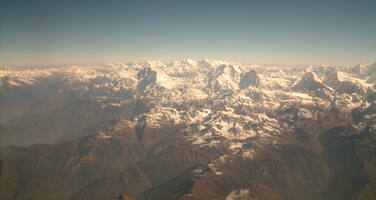Sagarmatha National Park
Factors affecting the property in 1997*
- Impacts of tourism / visitor / recreation
- Management systems/ management plan
- Solid waste
International Assistance: requests for the property until 1997
Total amount approved : 201,895 USD
| 1983 | Reafforestation programme, improvement of the display ... (Approved) | 10,000 USD |
| 1982 | Specialist services of an energy adviser and financial ... (Approved) | 61,995 USD |
| 1981 | Financial contribution and specialist services for a ... (Approved) | 54,900 USD |
| 1980 | Energy adviser, equipment and financial assistance for ... (Approved) | 75,000 USD |
Missions to the property until 1997**
Information presented to the Bureau of the World Heritage Committee in 1997
The Director of the Sagarmatha National Park presented a report on the state of conservation of this World Heritage area, at the Meeting of the South Asian World Natural Heritage Site Managers, held in New Delhi and Keoladeo National Park, during 16-19 January 1997. The Nepalese Army supports the Park management in law enforcement activities. About 3500 people belonging to the Sherpa community live in and around the Park and play a significant role as guides for the visitors to the Park. Tourism however, is placing an ever increasing energy demand on the sparse cover of woody vegetation left remaining in the area and introduces considerable problems of waste disposal.
The Director had proposed that the Park staff, Army personnel and the Sherpa community shift to using kerosene in order to meet their energy needs. The Director however, has been unable to raise the necessary capital, estimated to be about US$ 50,000, for making this shift in the source of energy. The Director was critical of the fact that the results of the various scientific studies carried out on conservation issues relevant to the Park are rarely made available to the management. He called for greater involvement of scientific expertise in advising the management on resolving practical problems; e.g. meeting energy needs of the Staff, Army personnel, the Sherpa community and the tourists without having to continue to depend on the sparse woody vegetation available in the area; managing waste disposal problems caused by a large number of visitors to the area etc.
Action Required
The Bureau requests IUCN to utilize expertise available in its Nepal Office in Katmandu to undertake a field visit to Sagarmatha National Park and discuss with the Director of the Park, ways and means by which they can provide regular advise on management issues.
Summary of the interventions
Decisions adopted by the Committee in 1997
21 BUR IV.B.29
Sagarmatha National Park (Nepal)
The Bureau was informed that about 3500 people belonging to the Sherpa community live in and around the Park and play a significant role as guides for the visitors to the Park. Tourism however, is placing an ever increasing energy demand on the sparse woody vegetation left remaining in the area and also introduces considerable problems of waste disposal.
The Director of the Park had proposed that staff, army personnel and the Sherpa community resident in the vicinity of the Park shift to using kerosene as a primary source of energy but has been unable to raise the necessary capital, estimated to be about US$ 50,000, for making this shift. The Director has called for more involvement of scientific expertise in advising the management on resolving practical problems such as energy needs of the staff, army personnel, the Sherpa community and the tourists and the management of waste disposal. The Bureau requested IUCN to utilize expertise available in its Nepal Office in Katmandu to undertake a field visit to Sagarmatha National Park and discuss with the Director of the Park, ways and means by which they can provide advise on alternative energy sources and other management issues. The IUCN Representative pointed out that funding would be required to support IUCN involvement.
* :
The threats indicated are listed in alphabetical order; their order does not constitute a classification according to the importance of their impact on the property.
Furthermore, they are presented irrespective of the type of threat faced by the property, i.e. with specific and proven imminent danger (“ascertained danger”) or with threats which could have deleterious effects on the property’s Outstanding Universal Value (“potential danger”).
** : All mission reports are not always available electronically.


